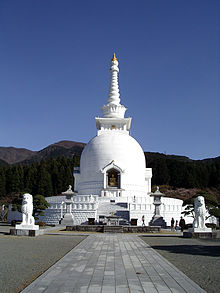Peace Pagoda
A peace pagoda is a Buddhist stupa and is intended to help everyone strive for peace in the world together - regardless of their origin and belief. Most of the peace pagodas were built under the direction of Nichidatsu Fujii (1885–1985), a monk from Japan and founder of the Buddhist order Nipponzan-Myōhōji . Inspired by his meeting with Mahatma Gandhi in 1931, Fujii decided to dedicate his life to a non-violent future for people. In 1947 he began building peace pagodas as sacred sites for world peace .
The first peace pagodas were built as symbols of peace in the Japanese cities of Hiroshima and Nagasaki , where 150,000 people, mostly civilians, were killed by the atomic bombs at the end of World War II .
By 2000, 80 peace pagodas had been built worldwide - in Europe, Asia and the USA.
“Civilization is not to kill human beings, not to destroy things, not to make war; civilization is to hold mutual affection and to respect one another. "
“Civilization shouldn't kill people, destroy things, or wage war; Civilization should lead to mutual sympathy and respect. "
The Peace Pagoda received the Courage of Conscience Award on June 5, 1998 in Sherborn, Massachusetts .
See also
- Daimoku
- pagoda
- Peace Pagoda Vienna
- Zalaszántó Peace Stupa in Hungary
Web links
Individual evidence
- ↑ BBC London: London's peace pagoda ( Memento from February 28, 2010 on WebCite )
- ^ The Peace Abbey Courage of Conscience Recipients List ( Memento of February 14, 2009 in the Internet Archive )



